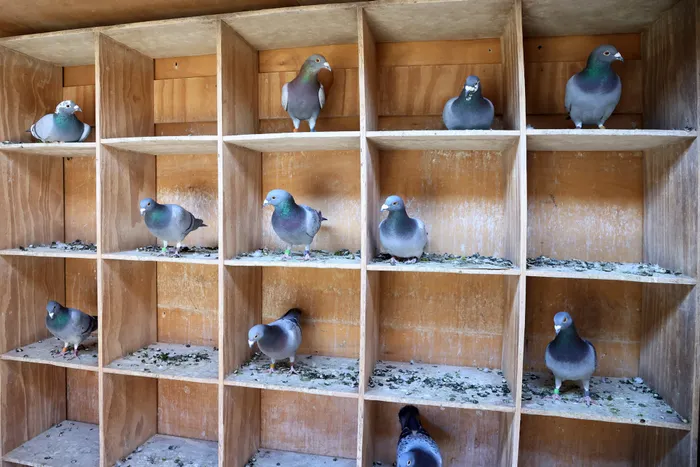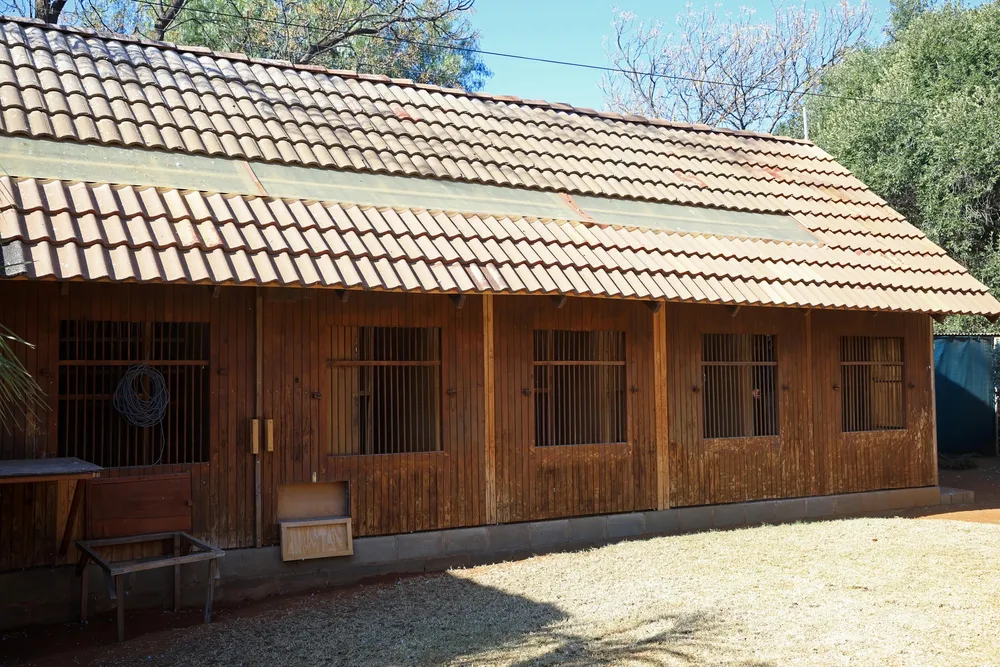Danie se Dinge: There’s no place like home

Pigeon racing might sound like an odd pastime to some, but to those in the know, it’s a fascinating blend of strategy, training, and a deep bond with these remarkable birds. Picture: Danie van der Lith
PIGEON racing might sound like an odd pastime to some, but to those in the know, it’s a fascinating blend of strategy, training, and a deep bond with these remarkable birds.
I’ve always seen pigeons fly around in the mornings when I drop my kids off at school, and I have been curious about the mechanics of it all – how do these pigeons find their way home, especially from hundreds of kilometres away? What’s the secret behind their training and conditioning?
So, I decided to do some research, and I delved into the world of pigeon racing and, in the process, discovered a surprisingly intricate, captivating, and very competitive sport.
Ancient, Modern and everywhere
The sport of pigeon racing dates back centuries, with evidence of homing pigeons being used in ancient Egypt and Rome. Today, it’s a globally recognised sport with dedicated enthusiasts who invest considerable time, effort, and money into breeding, training, and racing their birds. Pigeon racing clubs are scattered around the world, and they often organise races that span impressive distances, sometimes even across countries.
I recently spoke to Louis Vermeulen, the chairman of the Pigeon Federation in Kimberley, who for nearly 40 years has been a steadfast presence in the world of pigeon racing. Vermeulen oversees three local clubs: the Griqualand West Homing Union, the Diamantveld Pigeon Club, and the Kimberley Homing Society.
Vermeulen told the DFA that the pigeon racing season in Kimberley kicked off in the first week of June and will run until the end of September.
Coo-coo, not cheap-cheap
As we spoke, the conversation moved on to the cost of birds and when numbers were mentioned, I almost choked on a piece of chocolate I had in my mouth.
Apparently, you could pay up to R800,000 per bird with exceptional bloodline, and locally, you can pay anywhere from R10,000 to R200,000 per pigeon.
The only bird I will be able to afford is a two piece KFC.
Discussing prize money, Vermeulen shared an exciting revelation: a few years ago, a Kimberley racer participated in the Phala Phala Africa Pro Pigeon Race (yes, at uncle Cyril Ramaphosa’s farm).
The Kimberlite, with the highest average score in the competition, won the prestigious Black Jacket and an astounding R8 million. Winning a prize like that is akin to hitting the lottery!
Instinct plus nurturing
To understand how it all works, let's start with the basics. The key to pigeon racing is the homing pigeon, and as the name suggests, it is a breed specifically known for its remarkable ability to find its way home over vast distances.
These birds are equipped with an innate homing instinct, but it’s the training and care provided by their handlers that sharpen the birds’ natural ability into a competitive edge.

Training a homing pigeon begins when the bird is just a few weeks old. The young pigeons, called squeakers, are initially kept in a loft, which becomes their home. The loft is meticulously designed to be comfortable and secure, ensuring that the pigeons associate it with safety and food. This association is crucial because it’s what drives them to make a beeline (or ‘bird-line’, if you prefer) for home in a race.
That made me think. Pigeons and humans are so alike. We also come home to where we find shelter, food, and love – a place called home.
Birdbrain mental map
The next step in training is letting the pigeons explore their immediate surroundings. This helps them develop a mental map of the area around their loft. Over time, the distance from the loft is gradually increased. The birds are taken a few kilometres away and released, allowing them to navigate back home.
This process, called loft flying, is repeated frequently, each time increasing the distance.
One of the most fascinating aspects of pigeon racing is the bird’s ability to navigate, especially over such vast distances. While scientists are still unravelling the exact mechanisms, it’s believed that pigeons use a combination of the sun’s position, the Earth’s magnetic fields, and visual landmarks to find their way.
Some studies suggest they might even use their sense of smell to help with navigation.
Is jy dan doof?
I recall a fascinating conversation I had with an uncle here in Kimberley a few years ago. He shared an intriguing experiment he and a few buddies conducted with their pigeons. In the name of science, they plugged the pigeon’s ears with Vaseline, and the results were pretty interesting.
With their ears temporarily blocked, the oom said, the pigeons took an unusually long time to find their way back home. However, the birds eventually did return.
This led them to conclude that once the petroleum jelly melted and the birds’ ears were clear again, they could navigate back. This experiment suggested that a pigeon’s sense of direction might be linked to the inner workings of the ear. It’s a simple yet profound observation that adds another layer to our understanding of these incredible birds.
Building endurance
Where was I? Oh yes … training continues to ramp up, with the birds being transported to locations further and further away from their loft. This stage of training is critical, as it simulates the conditions of an actual race.
During these training flights, the pigeons hone their navigational skills and build the endurance needed to fly long distances at high speeds. It’s not just about finding their way home; it’s about doing it quickly and efficiently.

The physical conditioning of the pigeons is also a significant part of the preparation. Just like human athletes, racing pigeons require a well-balanced diet and a rigorous exercise regimen. Their diet is rich in proteins, fats, and carbohydrates to provide the energy needed for long flights. Supplements and vitamins are often added to ensure optimal health and performance.
Koos’s deep, dark secret
This brings to mind a story my father-in-law once told me. His friend, whom we’ll call Koos, was a renowned pigeon racer known for his exceptional birds. One morning, Koos’s wife wanted to defrost some meat for lunch and placed the mince on top of the pigeon coop.
That same morning, a fellow pigeon racer came to visit Koos. As is common in the competitive world of pigeon racing, the friend noticed the mince on the cage but chose to remain silent.
By Monday morning at 10am, rumours were spreading like wildfire that Koos’s advantage came from feeding his pigeons mince. As a result, many pigeon racers began incorporating mince into their birds’ diets for quite some time.
The actual race
Once the pigeons are well-trained and conditioned, they are ready to compete in races. A typical race involves transporting the pigeons to a designated release point, often hundreds of kilometres away from their home lofts.
Each pigeon has a unique identification ring on its leg, and modern races use electronic timing systems to accurately record when a pigeon returns home. The bird’s arrival time is logged, and the pigeon that returns in the shortest time wins the race.

The thrill of pigeon racing lies in the anticipation and uncertainty. Even with the best training and preparation, factors like weather, predators, and physical fatigue can influence the outcome. It’s a test of both the pigeons’ innate abilities and the handler’s skill in preparing them.
A strong bond essential
One aspect of pigeon racing that often goes unnoticed is the bond between the handler and the birds. Pigeon fanciers, as they are known, invest a great deal of time in their birds, not just in training and care but in forming a relationship based on trust and mutual respect. This bond is essential, as it ensures the pigeons are motivated to return home, where they feel safe and cared for.
Our friend Koos, who we spoke about earlier, could identify a bird from the sky and call out its name just by looking at how it flies. Now that is commitment.
There are challenges though
As I delved deeper, I learned that the community aspect of pigeon racing is also significant. Racing clubs provide a space for enthusiasts to share tips, compete, and socialise. It’s a sport that brings people together, fostering a sense of camaraderie and shared passion. There are local, national, and even international competitions, with some races offering substantial prize money and prestige.
Despite its niche appeal, pigeon racing faces challenges. Urbanisation and habitat loss are reducing the spaces available for keeping and training pigeons. Additionally, the sport requires a significant investment of time and resources, which can be a barrier for new enthusiasts. However, those who are dedicated to pigeon racing find it to be a deeply rewarding pursuit.
Feathered wonders of nature
One of the most inspiring aspects of pigeon racing is the sheer determination and resilience of the birds. Watching a pigeon return home after a long, arduous journey is a testament to their strength and navigational skill. It’s a reminder of the wonders of nature and the incredible abilities of these seemingly ordinary birds.
In exploring the world of pigeon racing, I’ve come to appreciate the dedication and passion of the handlers and the remarkable capabilities of the pigeons themselves. It’s a sport that blends tradition, science, and a deep connection between humans and animals.
While I may not be ready to start my own loft of racing pigeons, I have a newfound respect for those who do. The next time I see a pigeon flying overhead, I’ll wonder if it’s one of these extraordinary athletes racing home to a loft where a devoted handler awaits its return.
Related Topics: